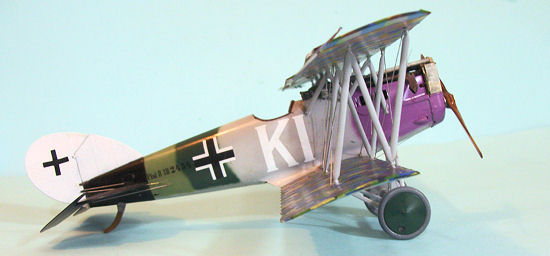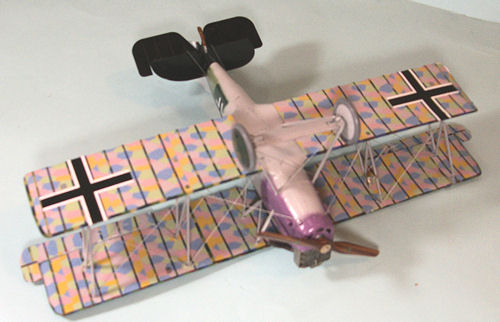WingnutWings 1/32 Pfalz D. XII
|
KIT #: |
32019 |
|
PRICE: |
$65.0 SRP |
|
DECALS: |
Five options |
|
REVIEWER: |
Tom Cleaver |
|
NOTES: |
|

The Pfalz D.XII was a thoroughly competent fighter
produced by a design team that had created the highly‑regarded D.III
series, which had the misfortune to arrive on the Western Front at the same time
as the magnificent Fokker D.VII,
compared to which any other contemporary aircraft design was bound to suffer in
the view of pilots who wanted to fly only the best.
In creating the D.XII, Chief Designer Rudolph Geringer
strove to solve the one major criticism of the D.III
series, the weakness of the sesquiplane layout, which prevented its pilots
throwing it around in combat with the complete abandon necessary to achieve true
greatness.
Both the Pfalz D.III
and the Albatros D.III
and D.V had been influenced by the Nieuport sesquiplanes; the design worked for
lightly‑loaded airplanes like the Nieuports, but not for more heavily‑loaded
airplanes with inline engines like the Pfalz and Albatros fighters, though the
Pfalz design was stronger since it had a two-spar lower wing.
The D.XII was
 influenced
by the S.P.A.D.
VII
and XIII fighters which were fast, heavily‑loaded, and able to out‑dive all
German fighters they opposed until the advent of the Fokker D.VII.
influenced
by the S.P.A.D.
VII
and XIII fighters which were fast, heavily‑loaded, and able to out‑dive all
German fighters they opposed until the advent of the Fokker D.VII.
The First Fighter Competition in January 1918 was a
watershed event for German fighter development.
German pilots demanded that German designers concentrate
on speed over maneuverability, as their Allied opponents were doing. The Fokker
D.VII
won the competition and went on to achieve large production orders.
The D.XII was still under construction and unable to
take part in this event.
When the prototype did fly in March 1918, its
performance was judged sufficiently good to merit a production order for 50 in
April, ahead of the Second Fighter Competition that was eventually held that
May. Unfortunately for Pfalz, the BMW.IIIa engine just coming into production ‑
which significantly improved the performance of the D.XII ‑ was in short supply
and Idflieg assigned all available
engines to Fokker D.VIIf production, forcing Pfalz to power the D.XII with the
inferior Mercedes D.III
engine.
The D.XII began to arrive among the active squadrons
during July 1918.
Many Jastas
operated both the Fokker D.VII
and Pfalz D.XII together.
Leutnant Rudolf Stark, commander of Jasta 35, said,
“During the larger operations, we flew the Fokker D.VII
and the Pfalz D.XII mostly together.
Both types were similar but the Fokker was more
maneuverable.
Therefore the Pfalz pilots had orders from me, during attacks by
the enemy, to fly below the Fokkers.”
Units in quieter sectors of the front were completely
equipped with the D.XII.
The airplane was not easy to fly and pilots had
difficulty with it.
Pilot reports indicated that the airplane climbed well
and could dive faster than the D.VII,
but it tended to lose height rapidly in a tight turn and could not compete with
the D.VII
in terms of maneuverability.
One said, “The Pfalz was a sluggish work horse which
fought bridle and had to be controlled with a strong halter.”
Others reported it had flying qualities much like the
SPAD, having an abrupt stall and a tendency to spin with little provocation.
Due to the design differences of the wing, it could not
“hang on its nose” like the D.VII.
The D.XII did relieve the shortage of fighters on the
Western Front and was a more than adequate replacement for the 470
 Pfalz.
DIIIa and Albatros D.Va fighters still in front line service on August 1, 1918.
Had it appeared in large numbers in March at the outset
of Case Michael, the German offensive
to end the war, powered by the superlative BMW.IIIa engine, its reputation would
be far different.
Pfalz.
DIIIa and Albatros D.Va fighters still in front line service on August 1, 1918.
Had it appeared in large numbers in March at the outset
of Case Michael, the German offensive
to end the war, powered by the superlative BMW.IIIa engine, its reputation would
be far different.
Several D.XIIs were taken to the
United States
after the war, and following tests by the
U.S.
Army Air Service, they were sold as surplus.
Three ended up being used by Howard Hughes for the
flying sequences of his aviation epic, “Hells Angels,” and while two were used
in the aerial sequences of “The Dawn Patrol” that was shot contemporaneously
with both “Hells Angels and Wings.”
This aerial footage was used in both the 1932 and 1936
versions of “The Dawn Patrol.”
At least one still exists in what was the Champlin
Fighter Collection, which is now part of the
Seattle
Museum
of Flight. A Pfalz D.XII is also on display at the Australian War Memorial.
It's hard to believe that this Pfalz D.XII is the
eighteenth kit released by Wingnut Wings, but it is.
It was a “surprise” release this past spring after the
F.E.2b kits and the Rumpler kits.
As with all Wingnut Wings products, the kit is
well-designed for detail and ease of assembly, with the no w-standard
fully-equipped and detailed cockpit and engine area, with a beautiful
Daimler-Mercedes D.IIIa engine.
The wings are both one-piece with separate ailerons,
while the tail surfaces all have separate controls.
Molding detail accurately recreates what a
fabric-covered surface looks like.
w-standard
fully-equipped and detailed cockpit and engine area, with a beautiful
Daimler-Mercedes D.IIIa engine.
The wings are both one-piece with separate ailerons,
while the tail surfaces all have separate controls.
Molding detail accurately recreates what a
fabric-covered surface looks like.
Five sets of markings are provided, including all the
“usual suspects” from other D.XII kits that have been released over the years.
None are “planes the aces flew” because there is no
record that any aces flew the D.XII.
If particular note are the lozenge wing decals.
They are printed with the lozenge fabric rib tapes, so
that one does not have to do the tiresome business of cutting individual rolls
of lozenge, apply them, then individually apply the rib tapes.
These decals go on easily, with no possibility of
getting things messed up with the various stages of application as previously.
Sir Peter Jackson, the owner of Wingnut Wings, told his
kit designers that these kits were to be the kind that could be built by average
modelers who had previously shied away from World War I models, and this kit is
definitely an example of that philosophy.
 As with all Wingnut Wings kits, open the comprehensive
instruction booklet and follow it.
I have found it very helpful to pre-paint all the parts
before proceeding with assembly, which I did here.
As with all Wingnut Wings kits, open the comprehensive
instruction booklet and follow it.
I have found it very helpful to pre-paint all the parts
before proceeding with assembly, which I did here.
I painted the radiator with Tamiya “Gunmetal” and then
gave it a wash of thinned Tamiya “Semi-gloss Black” to pop out the detail. I did
the same thing with the machine guns.
I used an Eduard photoetch German WW1 seatbelt set, not
because it is better than what the kit provides but rather because it was
pre-painted and I was lazy.
The interior was painted with Tamiya “RLM Grey” which is
as likely accurate as any other color for the “Pfalz grey” that was used.
It might also have been “Silbergrau” but I suspect not,
and so does Wingnut Wings.
I mixed Tamiya “Flat Aluminum” with “Sky Grey” and “Flat
White” to get the “Silbergrau” color.
 I mixed Tamiya “Purple” with white to get the “lilac”
color for the nose.
I used Tamiya “Mitsubishi Green (IJN Dark Green #2) for
the dark green and Tamiya “Japanese Cockpit Color” for the light green,
following Wingnut's suggestions.
The tires were painted Tamiya “Dark Grey.”
I mixed Tamiya “Purple” with white to get the “lilac”
color for the nose.
I used Tamiya “Mitsubishi Green (IJN Dark Green #2) for
the dark green and Tamiya “Japanese Cockpit Color” for the light green,
following Wingnut's suggestions.
The tires were painted Tamiya “Dark Grey.”
I then applied two coats of Xtracrylix Clear Gloss
varnish.
I did the lozenge decals for the wings first, doing
first the lower surfaces and then the upper surfaces.
Be certain to do it in this order, because the upper
color rolls over the leading edge of the wings, over the lower color.
These decals, which have the rib tapes printed and are
designed to fit in large sections, make doing lozenge so easy that anyone can do
it successfully; if certainly gets rid of some drudgery associated with German
airplanes that use this camouflage.
The national insignia and individual markings were
applied after the lozenge decals had completely set up.
I assembled the model and then rigged it with .008 wire.
Using wire and attaching it with cyanoacrylate glue
makes an otherwise-fragile model much more sturdy.
The Pfalz D.XII may not have had a major war record, but
it is a good-looking airplane and certainly has become a “classic” over the
years.
As with all the other Wingnuts kits, this model goes together easily and
rapidly, and the result looks good.
The rigging of this model is simple enough that a
modeler just getting into the genre would find it a good “first kit.”
The finished model looks very nice sitting next to the
Wingnut Pfalz D.III
and Albatros D.V.
Highly recommended.
Tom Cleaver
October 2012
Review kit courtesy of
my wallet.
Copyright ModelingMadness.com. All rights reserved. No reproduction in part or in whole without express permission.
If you would like your product reviewed fairly and
fairly quickly, please
contact
the editor or see other details in the
Note to
Contributors.
Back to the Main Page
Back to the Review
Index Page 2024


 influenced
by the S.P.A.D.
influenced
by the S.P.A.D.  Pfalz.
DIIIa and Albatros D.Va fighters still in front line service on August 1, 1918.
Had it appeared in large numbers in March at the outset
of Case Michael, the German offensive
to end the war, powered by the superlative BMW.IIIa engine, its reputation would
be far different.
Pfalz.
DIIIa and Albatros D.Va fighters still in front line service on August 1, 1918.
Had it appeared in large numbers in March at the outset
of Case Michael, the German offensive
to end the war, powered by the superlative BMW.IIIa engine, its reputation would
be far different. w-standard
fully-equipped and detailed cockpit and engine area, with a beautiful
Daimler-Mercedes D.IIIa engine.
The wings are both one-piece with separate ailerons,
while the tail surfaces all have separate controls.
Molding detail accurately recreates what a
fabric-covered surface looks like.
w-standard
fully-equipped and detailed cockpit and engine area, with a beautiful
Daimler-Mercedes D.IIIa engine.
The wings are both one-piece with separate ailerons,
while the tail surfaces all have separate controls.
Molding detail accurately recreates what a
fabric-covered surface looks like.
 I mixed Tamiya “Purple” with white to get the “lilac”
color for the nose.
I used Tamiya “Mitsubishi Green (IJN Dark Green #2) for
the dark green and Tamiya “Japanese Cockpit Color” for the light green,
following Wingnut's suggestions.
The tires were painted Tamiya “Dark Grey.”
I mixed Tamiya “Purple” with white to get the “lilac”
color for the nose.
I used Tamiya “Mitsubishi Green (IJN Dark Green #2) for
the dark green and Tamiya “Japanese Cockpit Color” for the light green,
following Wingnut's suggestions.
The tires were painted Tamiya “Dark Grey.”